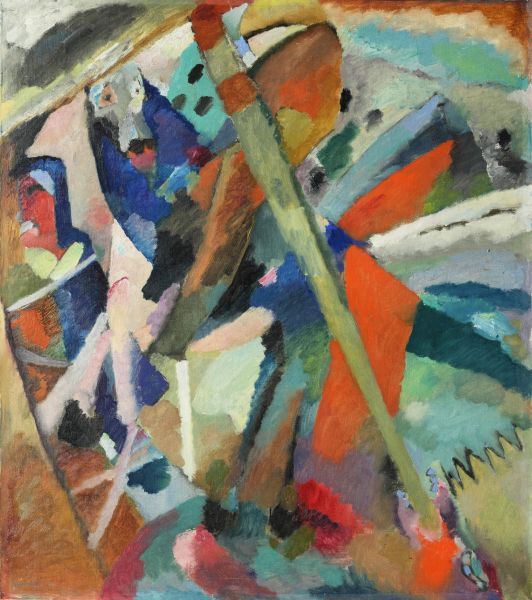|
|
St George (II). 1911

Kandinsky Vasili,
Oil on canvas
107 х 95,2
State Russian Museum
Пост. в 1926–1928 из МХК через ГИНХУК, Ленинград
Annotation
St George is from the very beginning of the artist’s abstract period. The Russian icons or lubki may have served as the impetus for the creation of this version of St George. In his chosen motif, the artist was not concerned with naturalistic collisions of battle, but its emotional atmosphere, the stress of combat, and the pathos and joy of victory. He achieved this with the composition itself and the development of its musical “drama”.In the chaos of filling the canvas with expressivespots of colour, the outlines of the rocks, the figuresof the princess and the horseman, who is strikinga dragon, are still discernable. It gives rise to associations,and these recognisable details enrichthe image, making the layers of multiple meaningseven stronger. But like musical sounds, the forms,combinations and contrasts of the spots of colour inthis work are liberated from the shackles of havinga concrete subject, and are still able to convey theconditions of its creator’s soul and spirit.
Author's Biography
Kandinsky Vasili
Kandinsky, Wassily (Vasily Vasilyevich)
1866, Moscow - 1944, Neuillysur-Seine (France)
Painter, graphic artist, book illustrator, writer on painting and poetry. Studied law and political economy at the Moscow University (1885-93). Studied art at Anton Aube's private studio (1896-97) and the Akademie Franz von Stuck in Munich (1900). One of the founders of the Phalanx group (1901), organised the Neue Kimst-lervereinigung in Munich (1909). Contributed to the exhibitions of the Jack of Diamonds (1910, 1912), Der blaue Reiter (1911-12) and Galerie Der Strum (1913). Worked for Department of An, People's Commissariat of Education (1918), headed the Museum of Painterly Culture in Moscow (1919-20). Emigrated to Germany (1921) and France (1933).

